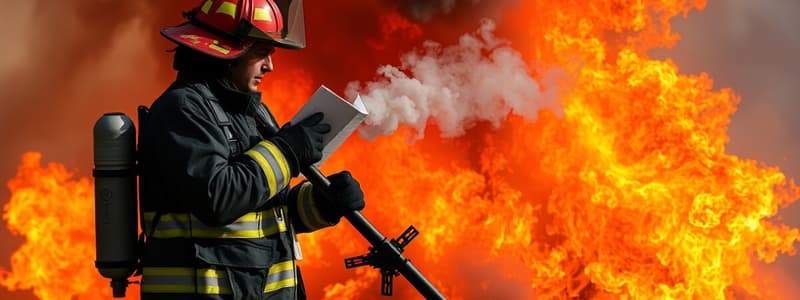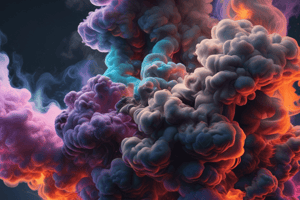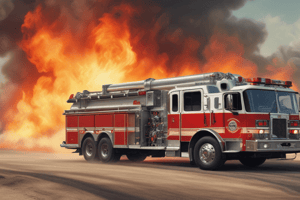Podcast
Questions and Answers
Where is reading smoke adapted from?
Where is reading smoke adapted from?
The art of reading smoke by Dave Dodson and Reading smoke by Gary Ells.
Why do we read smoke? (5 things)
Why do we read smoke? (5 things)
To help determine what we have, where it's at, predict where it's going, predict what is going to happen, and better plan to deal with it.
What will evaluating smoke allow us to determine and plan for? (5 things)
What will evaluating smoke allow us to determine and plan for? (5 things)
Size and extent of the incident, speed and direction of fire spread, degree of heat release and stage of fire, possible adverse fire events, and appropriate prioritization of strategics and tactics.
What is smoke?
What is smoke?
The specific definition of smoke matters less than ____ ____ ____ ____.
The specific definition of smoke matters less than ____ ____ ____ ____.
What are toxic gases included in smoke?
What are toxic gases included in smoke?
Besides being toxic and poisonous, most toxic gases are ______.
Besides being toxic and poisonous, most toxic gases are ______.
Carbon monoxide has a flammable range of what at 1200F?
Carbon monoxide has a flammable range of what at 1200F?
What is the composition of smoke?
What is the composition of smoke?
The bottom line is, smoke is _______ _____.
The bottom line is, smoke is _______ _____.
Why is reading smoke more important now than ever before?
Why is reading smoke more important now than ever before?
Today's structures exhibit materials with considerably less mass than yesterday's. Why?
Today's structures exhibit materials with considerably less mass than yesterday's. Why?
In terms of a structure fire, mass = what?
In terms of a structure fire, mass = what?
How has the composition of fuels changed?
How has the composition of fuels changed?
Plastics put off ____ the BTU's as normal class A fuels.
Plastics put off ____ the BTU's as normal class A fuels.
Plastics produce _____ ____ clouds of smoke with more flammable gases than normal class A fuels.
Plastics produce _____ ____ clouds of smoke with more flammable gases than normal class A fuels.
Why is understanding the composition change of fuel important?
Why is understanding the composition change of fuel important?
Structures have changed as well. How?
Structures have changed as well. How?
Better insulation leads to?
Better insulation leads to?
In what ways have fuels changed?
In what ways have fuels changed?
How has our equipment changed?
How has our equipment changed?
Equipment changes allow us to?
Equipment changes allow us to?
All changes in fuel and equipment add up to an increased exposure to extreme ____ _____ events for today's FF.
All changes in fuel and equipment add up to an increased exposure to extreme ____ _____ events for today's FF.
The ability to read smoke will allow us to?
The ability to read smoke will allow us to?
Smoke has trigger points. What are they?
Smoke has trigger points. What are they?
_____ _____ of the smoke is a very important factor to consider.
_____ _____ of the smoke is a very important factor to consider.
When predicting fire events, we need to be able to determine what three things?
When predicting fire events, we need to be able to determine what three things?
Smoke flow can be either _____ or ______.
Smoke flow can be either _____ or ______.
What fire events do we want to predict?
What fire events do we want to predict?
What is flashover?
What is flashover?
What are interior warning signs of flashover?
What are interior warning signs of flashover?
What are exterior warning signs of flashover?
What are exterior warning signs of flashover?
What is backdraft?
What is backdraft?
What are warning signs of backdraft?
What are warning signs of backdraft?
What is smoke explosion?
What is smoke explosion?
What are warning signs of smoke explosion?
What are warning signs of smoke explosion?
Rapid fire spread is usually ______ influenced.
Rapid fire spread is usually ______ influenced.
What should you look for in regards to rapid fire spread?
What should you look for in regards to rapid fire spread?
Fuel for fire spread is _____ ____ vs. contents surface flaming.
Fuel for fire spread is _____ ____ vs. contents surface flaming.
Cold lazy smoke could cause ______ _____ while fast moving smoke could cause _____ _____ _____
Cold lazy smoke could cause ______ _____ while fast moving smoke could cause _____ _____ _____
Reading smoke to predict what is happening or going to happen is a ____ step process.
Reading smoke to predict what is happening or going to happen is a ____ step process.
Visible fire is easy to read, look beyond it for the ____ ____.
Visible fire is easy to read, look beyond it for the ____ ____.
When reading smoke, the observations are typically made from the ________.
When reading smoke, the observations are typically made from the ________.
_______ observations hide the real picture.
_______ observations hide the real picture.
What are the 4 steps to reading smoke?
What are the 4 steps to reading smoke?
What 4 attributes should we assess when evaluating the smoke?
What 4 attributes should we assess when evaluating the smoke?
What does volume of smoke mean?
What does volume of smoke mean?
What does the volume of smoke tell us?
What does the volume of smoke tell us?
Volume of smoke is relative to?
Volume of smoke is relative to?
Volume of smoke is typically described as ____ or ____.
Volume of smoke is typically described as ____ or ____.
What is the velocity of smoke?
What is the velocity of smoke?
Velocity of smoke leaving the building is indicative of what?
Velocity of smoke leaving the building is indicative of what?
The velocity of smoke indicates either _____ or ______.
The velocity of smoke indicates either _____ or ______.
The velocity of smoke helps us locate?
The velocity of smoke helps us locate?
What is the rule of thumb in regards to velocity?
What is the rule of thumb in regards to velocity?
What is the most important factor when reading smoke?
What is the most important factor when reading smoke?
What is the density of smoke?
What is the density of smoke?
Changes in density can indicate?
Changes in density can indicate?
Density tells us the ______ of burning.
Density tells us the ______ of burning.
Density helps us predict the likelihood of?
Density helps us predict the likelihood of?
Density tells us how bad things are going to be.
Density tells us how bad things are going to be.
What are the colors of smoke?
What are the colors of smoke?
Odd colors of smoke may indicate?
Odd colors of smoke may indicate?
Looking at the color of smoke will tell us the _____ ____ ____.
Looking at the color of smoke will tell us the _____ ____ ____.
The color of smoke will help us determine the _______ of fire.
The color of smoke will help us determine the _______ of fire.
Read the factors, what is it? Volume: Light, Velocity: Lazy and slow, Density: Thin and transparent, Color: Off white to gray.
Read the factors, what is it? Volume: Light, Velocity: Lazy and slow, Density: Thin and transparent, Color: Off white to gray.
Read the factors, what is it? Volume: Heavy, Velocity: Moderate and very turbulent, Density: Very opaque, Color: Dark grey to black.
Read the factors, what is it? Volume: Heavy, Velocity: Moderate and very turbulent, Density: Very opaque, Color: Dark grey to black.
Read the factors, what is it? Volume: Heavy, Velocity: Rapid and turbulent, Density: Translucent to opaque, Color: Grey to dark grey.
Read the factors, what is it? Volume: Heavy, Velocity: Rapid and turbulent, Density: Translucent to opaque, Color: Grey to dark grey.
Read the factors, what is it? Volume: Heavy, Velocity: Moderate speed and heavy turbulence, Density: Opaque to very opaque, Color: Dark gray, brown, yellowish.
Read the factors, what is it? Volume: Heavy, Velocity: Moderate speed and heavy turbulence, Density: Opaque to very opaque, Color: Dark gray, brown, yellowish.
Read the factors, what is it? Volume: Large amounts of light smoke, no smoke, puffing out of cracks, Velocity: Puffing, Density: Translucent to opaque, Color: Light gray to gray, yellowish gray.
Read the factors, what is it? Volume: Large amounts of light smoke, no smoke, puffing out of cracks, Velocity: Puffing, Density: Translucent to opaque, Color: Light gray to gray, yellowish gray.
Weighing all factors includes?
Weighing all factors includes?
How do you judge the rate of change? (step 3)
How do you judge the rate of change? (step 3)
One hostile event can _____ to another.
One hostile event can _____ to another.
_____ your observations.
_____ your observations.
Warning signs are not always visual, therefore you should?
Warning signs are not always visual, therefore you should?
Sealed buildings ______ the smoke.
Sealed buildings ______ the smoke.
Prior to entering, you should allow the smoke to _____ for a few seconds. Why?
Prior to entering, you should allow the smoke to _____ for a few seconds. Why?
What is 'burping the building'?
What is 'burping the building'?
The higher the hydrocarbon content of the fuel:
The higher the hydrocarbon content of the fuel:
Hot smoke moves _____ near the seat of the fire.
Hot smoke moves _____ near the seat of the fire.
How can you observe how fast smoke is moving while inside a structure?
How can you observe how fast smoke is moving while inside a structure?
Gray-black smoke with velocity and turbulence suddenly clearing indicates?
Gray-black smoke with velocity and turbulence suddenly clearing indicates?
What does dense black smoke indicate?
What does dense black smoke indicate?
What does dirty white-gray smoke with no pressure that hangs in the air indicate?
What does dirty white-gray smoke with no pressure that hangs in the air indicate?
What does a large volume of white smoke and no heat, or smoke that is translucent indicate?
What does a large volume of white smoke and no heat, or smoke that is translucent indicate?
Operating sprinklers show grey smoke outside with cool, dense smoke inside. What is this prime for?
Operating sprinklers show grey smoke outside with cool, dense smoke inside. What is this prime for?
Fires in unventilated void spaces will _____ or have a ____ ____.
Fires in unventilated void spaces will _____ or have a ____ ____.
What are common void spaces you should address early?
What are common void spaces you should address early?
The bigger the void space:
The bigger the void space:
When dealing with void spaces, ventilate them vertically or ____ ____ prior to opening.
When dealing with void spaces, ventilate them vertically or ____ ____ prior to opening.
How would you apply water to a void space?
How would you apply water to a void space?
Heat creates _____, this pushes the smoke out.
Heat creates _____, this pushes the smoke out.
Flashcards are hidden until you start studying
Study Notes
Reading Smoke Overview
- Reading smoke is a crucial skill in firefighting adapted from works by Dave Dodson and Gary Ells.
Purpose of Reading Smoke
- Aids in determining fire presence, location, and predictive analysis of fire behavior.
- Assists in strategic planning for firefighting efforts.
Evaluating Smoke
- Key factors include:
- Size and extent of the incident
- Speed and direction of fire spread
- Degree of heat release and fire stage
- Possible adverse fire events
- Prioritization of tactics.
Definition and Composition of Smoke
- Smoke is the visible vapor from burning substances, primarily composed of gases, aerosols, and particulates.
- Contains toxic gases like carbon monoxide, hydrogen cyanide, and nitrogen oxides.
Flammability and Toxicity
- Most toxic gases in smoke are also flammable.
- Carbon monoxide has a flammable range of 12-75% at 1200°F.
Composition Changes in Fuels
- Recent years have seen an increase in synthetic materials, which burn hotter and yield thicker black smoke.
- Plastics generate double the BTUs compared to traditional Class A fuels.
Structural Changes
- Modern buildings use engineered materials, leading to lower mass and better insulation, increasing heat retention.
- Better insulation can result in faster hostile event development.
Firefighting Equipment Advances
- Improvements include better turnout gear, SCBA usage, and faster notification systems.
- Such advancements allow for deeper entry and extended time in hotter environments.
Smoke Behavior Prediction
- Understanding changes in smoke with regards to volume, velocity, density, and color can inform about the fire's nature.
- Three predictive assessments involve fire stage, heat absorption, and smoke flow characteristics.
Flashover and Backdraft Signs
- Flashover is marked by heavy smoke, rollover, and faint visible flames.
- Backdraft is indicated by yellowish-gray smoke, sealed containers, and pressurization signs.
Smoke Explosion Risks
- Smoke explosions occur in adjacent chambers with smoke below ignition temperature, indicated by increasing smoke density and cool smoke in neighboring rooms.
Reading Smoke Techniques
- Observations should be made from the outside while considering potential danger signs inside.
- Four steps in smoke reading involve evaluating, weighing factors, judging changes, and predicting fire behavior.
Attributes to Assess When Reading Smoke
- Analyze smoke volume, velocity, density, and color for diagnostics:
- Volume: amount of smoke
- Velocity: indicates internal pressure
- Density: reflects conditions and potential fire spread
- Color: informs about fuel type and fire stage.
Key Indicators of Fire Stages
- Incipient fire shows light smoke volume and slow velocity.
- Pre-flashover displays heavy, turbulent smoke.
- Freeburning smoke is heavy with rapid flow, hinting at a well-ventilated fire.
Void Spaces and Fire Behavior
- Void spaces (e.g., knee walls) pose significant risks and should be ventilated appropriately.
- Use piercing nozzles or create small access holes to apply water safely in these areas.
Final Considerations
- Trust instincts as warning signs may not always be visually apparent.
- Address void spaces early in firefighting strategy to mitigate risks.
Studying That Suits You
Use AI to generate personalized quizzes and flashcards to suit your learning preferences.




